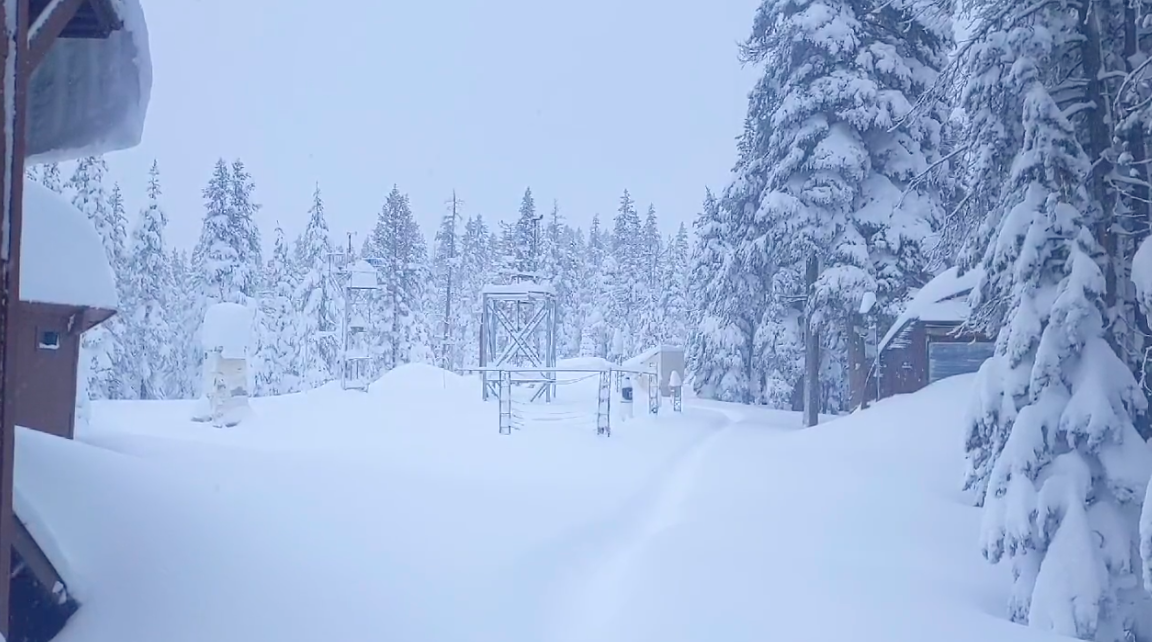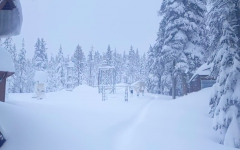
UC Berkeley Central Sierra Snow Lab. (Photo: cssl.berkeley.edu)
California Snowpack Reaches 250%, Reservoirs Begin To Fill From Recent Storms
Drought severity this year being lessened as a result of record rain/snow
By Evan Symon, January 17, 2023 12:52 pm
The first snowpack and reservoir measurements following the latest record-setting atmospheric river events in California have been found to be much higher than expected, with many drought ravaged areas across the state now either approaching normalcy or even going above pre-drought averages.
Before the storms came in late last year, California was still in severe drought statewide. Reservoirs across the state had been at under 30% capacity, with snowpack levels expected to top out at now more than around 160%, before dropping significantly down to under 50% by April 1st like previous years. Weather experts predicted that while the drought would be eased somewhat in the Spring, that California would still be at mega-drought levels.
However, those projections have been radically altered by the near constant “bomb cyclone” storms that have struck California in the last three weeks. On January 5th, snowpack levels had already reached a 40-year high with 174% of the average in the Sierra Nevadas, with reservoir levels slowly beginning to rise above the 30% capacity marks following dry land being fully recharged with water. On January 11th, snowpack had reached over 200%, while reservoirs across the state all began going above the 38% average being reported across the state last year, including the Don Pedro Reservoir being at 97% it’s normal January level, with Shasta coming in at 67%, Oroville at 85%, New Melones at 59%, and Trinity at 42%. Southern California reservoirs also saw large upticks as well.
On Tuesday, the California Department of Water Resources (DWR) announced that snowpack levels have reached nearly 250%. Specifically, the Northern Sierra region is currently at 209% of snowpack, with the Central Sierra/Tahoe region coming in at 246%, and the Southern Sierra region, which largely feeds the Central Valley and Southern areas of the state, at 288%. Some areas, such as the UC Berkeley Central Sierra Snow Lab, reported 49.6 inches of snow falling between last Friday and Monday, contributed to the record levels of snowpack.
Additionally, reservoirs across the state have been filling up rapidly during the last week. Four reservoirs in Santa Clara County alone topped out at over 100% capacity, with others, while still under capacity, are quickly approaching average January levels. Shasta currently sits at 80% normal January capacity, with Oroville currently at 99%. Others include Don Pedro at 103%, Camanche at 122%, and Folsom being at 110%. In Southern California, reservoir levels are also better than expected, with Diamond Valley at 84% and LA County alone catching 33 billion gallons of rainwater for later public use – enough to supply over 800,000 people with water for a whole year.
Snowpack increases, reservoirs fill up across state
Despite the rain, experts still have noted that California is still in a drought. The rain has downgraded it to only being a “severe” drought, and where that level goes next depends on what happens in the next few months. For enough meltwater to provide Californians with enough water, snowpack levels need to be at 100% on April 1st. In the past several years, California has received near-record snowpack levels, but higher temperatures had dwindled that amount significantly by April 1st, with last year having snowpack levels at 160% in mid-January, but being at only 38% by the end of March, contributing to the bad drought last year.
“The rains have been a huge boon,” Jack Wesley, a water systems consultant for farms and multi-family homes, told the Globe on Tuesday. “I mean, they’ve been very destructive with all the flooding and deaths being around 20 now, but in term of watering the state, it was needed. But we need more rain stretched out throughout the year and not just huge rain bomb events like we’ve been getting. We need more reservoirs and better conservation and water recycling measures too. A lot of drought bills have been said to be coming up this year, and we can’t let the recent flooding sort of push them out of the way, because while we just got all this rain, we do need to prepare for dry years ahead still.”
“We’re going to see a lot of quickly written flood control bills, which are also very important, but we can’t just ignore whichever problem we aren’t having now. California gets bad drought, and we get bad floods. We need protection from both, and we need to prepare for both. The last few years should have taught us that. So yeah, I’m glad we got this rain and that it looks like we’ll have more water this year, but we are not over this quite yet, and we need new laws this year that protect against drought and floods alike. We can’t forget that.”
New snowpack and reservoir level figures are expected next week as final storms continue to make their way across the state this week.
- Bill to Require Law Enforcement Disclosure if AI Was Used To Help Write Reports - August 7, 2025
- Gov. Newsom Files FOIA Request To ‘Expose True Cost’ Of L.A. Federal Troop Deployment for Anti-ICE Riots - August 6, 2025
- California Redistricting: How Newsom’s Plan Will Demolish Hard Fought GOP Gains - August 6, 2025







We are going to have a incredible spring!
Some would have you believe these are drought conditions.
No matter how much it rains or how much snow falls, Gov. Newsom and Democrats will claim that we’re causing climate change so they’ll raise our taxes and pass more laws to control us. Meanwhile most of the water will continue to flow out to the ocean.
To me climate change and globle warming way to control in us. it maybe happening but at what rate? Not at the rate they make it seem. by us not drilling not getting our on an resources how much does it did it help. why buy & sell in it to communist countries. well our natural gas to china & buy oil from Iran. none that was happening when the other president was in charge766
the best of the best are out there trying to devise the best long term water diversion systems to capture much of that water that currently flows to the ocean. Since most of the so. cal. acreage is covered, there’s less room for designing and developing water diversion facilities above ground and tunneling takes time and extra funding during a time when the state is 22.3 billion in arrears. Fresh water flow into the ocean improves near shore fisheries and helps dissipate sewage contamination, so that spring flow serves multiple benefits.
Hopefully our ward bills will go down!
Build it dam it. Auburn Dam.
400-500 year flood protection of Sacto and valley; 2.3 million acre feet of water far cheaper than desalination of the Pacific Ocean, recycled sewage, and dribbling groundwater; 800 megawatts of cheap hydro power; water recreation for millions; and water for fish.
To those who would have you believe this is caused by man made Climate change.
Recently, researchers calculated that the eruption of Hunga Tonga-Hunga Ha’apa spewed a staggering 50 million tons (45 million metric tons) of water vapor into Earth’s atmosphere, in addition to enormous quantities of ash and volcanic gases.
And there still is no Sites Reservoir in sight.
It can be built fora fraction of what is being dumped into the Bullsh!? from one nowherevill to another nowhereville.
the best of the best are out there trying to devise the best long term water diversion systems to capture much of that water that currently flows to the ocean. Since most of the so. cal. acreage is covered, there’s less room for designing and developing water diversion facilities above ground and tunneling takes time and extra funding during a time when the state is 22.3 billion in arrears. Fresh water flow into the ocean improves near shore fisheries and helps dissipate sewage contamination, so that spring flow serves multiple benefits.